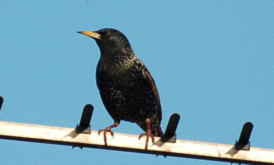People tend to use words like boisterous, greedy and noisy to describe starlings.
I have to disagree.
I have long admired them since a biology teacher told me what great birds they are and, as luck would have it, he absolutely proved his point.
This teacher had a licence to ring birds, so I used to find numerous different bird nests around the school grounds and inform him when the young had reached the correct age for ringing prior to leaving the nest.
One particular nest I lined up was a clutch of starling chicks, which involved a tall ladder, a head for heights and the removal of a couple of roof tiles to enable us to get at them.
All this effort was certainly worth it, because about 18 months later he had notification that one of the “rooftop chicks” had been found dead (killed by a raptor) on the outskirts of Moscow.
I vividly remember the excitement as we got out a map to work out how far it had travelled a couple of thousand miles, I seem to remember.
I often think that people don’t actually bother to look that closely at starlings, dismissing them as “dark and rather nondescript”.
Well, look again, I say.
During the winter months their plumage is covered all over in white speckles, giving a rather “Christmassy” look.
However, as spring approaches and they change into their breeding plumage, the speckles disappear and are replaced by an array of iridescent green and purple feathers which constantly alter as the sunlight catches them at different angles.
What also changes colour is the base of their long, yellow bills. I promise I’m not making this up, but it turns pink for girls and blue for boys.
The next top scoring quality of the starling is its singing. Okay, it does not have the finesse of the blackbird or perhaps the beauty of the nightingale, but it can’t be beaten for variety.
Starlings are great mimics, so that among all the standard clicks, whistles and squeaks most often delivered from a vantage point such as a television aerial, will suddenly come a perfect rendition of a car alarm, police siren or maybe another bird’s call.
Starlings used to be incredibly common, and caused problems in some of our cities as so many congregated to roost on buildings creating rather a lot of ‘guano’ in the process.
In fact, so many roosted on the hands of Big Ben in 1949 that they completely stopped the clock.
But starling populations have declined seriously, (by more than 70%) in recent times, and they are now on the red list of birds of high conservation concern.
There are several causes of this decline but changes in farming practices, especially in grassland management, have made it more difficult to find worms and leatherjackets to feed their young.
When starlings build their nests sometimes, but not always, they will add aromatic herbs to the lining of the nest.
It has been shown that the forming embryos in the eggs absorb certain chemicals given off by these herbs, boosting their white blood cell count and helping them fight infections. These lucky aromatherapy-treated chicks not only grow faster than non-treated chicks, but go on to have double the chance of making it through the first year of life.
I have left the biggest wow factor that the starling delivers until last: the amazing aerial displays that huge flocks of these birds can put on as they gather together just before going to roost.
Thousands of birds will all at once twist and turn in a closely bunched flock, almost like one complete organism, leading many to believe starlings are somehow capable of “thought transference” or “telepathy”, with each bird reading the others’ minds about where a flock would twist and turn next.
However, sometimes scientists can rather spoil things, as it has now been shown that starlings pay attention to their seven closest neighbours, reacting almost instantly to any move made by them.
Okay, but why seven? Apparently, interacting with the six or seven birds flying next to them optimises the balance between group cohesiveness and individual effort.
So, good at maths, mimicking, fashion, aromatherapy and long-distance travel. Don’t ever tell me that starlings are boring birds.
Peter Thompson is a field officer with the Game and Wildlife Conservation Trust.
